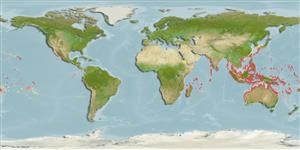Common names from other countries
>
Holocentriformes (Squirrelfishes, soldierfishes) >
Holocentridae (Squirrelfishes, soldierfishes) > Holocentrinae
Etymology: Sargocentron: Greek, sargos = sargus + Greek, kentron = sting (Ref. 45335).
More on author: Lacepède.
Environment: milieu / climate zone / depth range / distribution range
Ecologie
marien rifbewoner; diepte 1 - 20 m (Ref. 90102). Subtropical
Indo-West Pacific: East Africa south to Mozambique (but not the Red Sea) and east to the Marshall, except the northern Marshalls (Ref. 37816) and Society islands. Recorded from the Mediterranean as a Lessepsian migrant (Ref. 74657).
Grootte / Gewicht / Leeftijd
Maturity: Lm ? range ? - ? cm
Max length : 32.0 cm TL mannelijk / geslacht onbekend; (Ref. 5213); common length : 20.0 cm TL mannelijk / geslacht onbekend; (Ref. 3418)
Dorsale stekels (totaal): 11; Dorsale zachte stralen (totaal): 12-13; Anale stekels 4; Anale zachte stralen: 8 - 9. Body with dark brown to brownish red stripes, alternating with silvery white stripes. The upper 2 dark stripes often ending in an elongate dark brown spot at the base of the soft portion of the dorsal fin; the third curving downward to end at mid-base of caudal fin; the 4th ending just before the caudal peduncle; the 5th and 6th stripes converging posteriorly on lower edge of caudal peduncle; 7th and 8th ending in a dark blotch at the rear base of soft part of anal fin. Four oblique scale rows on cheek; body depth 2.6-2.8 in SL; head length (HL) 2.65-2.9 in SL; short and blunt snout, length 4.4-5.1 in HL; interorbital width 3.9-4.4 in HL; mouth terminal to slightly inferior, maxilla often extending to below center of the eye, upper jaw length 2.35-2.55 in HL; premaxillary groove often reaching above anterior edge of orbit; anterior end of nasal bone ending in a spine; surface or medial edge of nasal bone spineless; nasal fossa without spinules (occasionally large specimens with one spinule on anterior edge of fossa); upper edge of first suborbital bone with a slightly retrorse lateral spine, followed by a low ridge of recumbent spinules; preopercular spine 1.5-2.2 in orbit diameter, 3.7-5.8 in HL; 3rd-5th dorsal spines subequal, the longest 1.85-2.2 in HL; 3rd anal spine 1.25-1.5 in HL (Ref. 27370).
Inhabits reef flats and shallow protected reefs, often in dead reef areas (Ref. 9710). Secretive during the day (Ref. 37816).
Levenscyclus en paargedrag
Maturiteit | Voortplanting | Paaien | Eieren | Fecunditeit | Larven
Randall, J.E., 1998. Revision of the Indo-Pacific squirrelfishes (Beryciformes: Holocentridae: Holocentrinae) of the genus Sargocentron, with descriptions of four new species. Indo-Pac. Fish. (27):105 p. (Ref. 27370)
Status op de Rode Lijst van het IUCN (Ref. 130435)
CITES (Ref. 128078)
Not Evaluated
Gevaar voor de mens
Harmless
Gebruik door de mens
Visserij: van minder commercieel belang
Meer informatie
Lokale namenSynoniemenMetabolismePredatorenEcotoxicologieVoortplantingMaturiteitPaaienFecunditeitEierenOntwikkeling van de eieren
ReferentiesAquacultuurAquacultuurprofielKweeklijnenGeneticaElectrophoresesErfelijkheidZiektesVerwerkingMassaconversie
Tools
Speciale rapporten
Download XML
Internetbronnen
Estimates based on models
Preferred temperature (Ref.
115969): 24.8 - 29.3, mean 28.4 (based on 3239 cells).
Fylogenetische diversiteitsindex (Ref.
82804): PD
50 = 0.5000 [Uniqueness, from 0.5 = low to 2.0 = high].
Bayesian length-weight: a=0.01413 (0.00829 - 0.02406), b=2.98 (2.83 - 3.13), in cm Total Length, based on LWR estimates for this species & Genus-body shape (Ref.
93245).
Trofisch niveau (Ref.
69278): 3.5 ±0.48 se; based on food items.
Weerstandsvermogen (Ref.
120179): Hoog, minimale populatieverdubbelingstijd minder dan 15 maanden (Preliminary K or Fecundity.).
Fishing Vulnerability (Ref.
59153): Low vulnerability (22 of 100).
